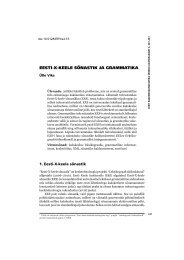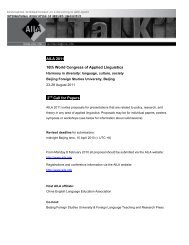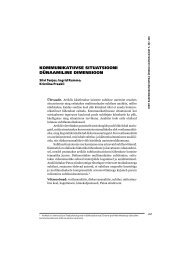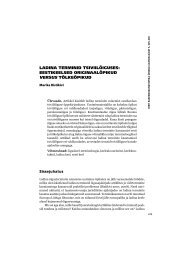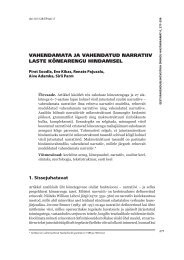ACQUISITION OF CASE IN LITHUANIAN AS L2: ERROR ANALYSIS
ACQUISITION OF CASE IN LITHUANIAN AS L2: ERROR ANALYSIS
ACQUISITION OF CASE IN LITHUANIAN AS L2: ERROR ANALYSIS
Create successful ePaper yourself
Turn your PDF publications into a flip-book with our unique Google optimized e-Paper software.
Table 2. The frequency distribution of cases (%) in spoken Lithuanian<br />
Case NOM GEN ACC DAT <strong>IN</strong>S LOC<br />
Percentage 32% 28% 18% 9% 5% 3%<br />
As Table 2 demonstrates, nominative and genitive are the most frequent cases,<br />
whereas dative, instrumental and locative are seldom used; accusative comes third<br />
on the frequency list.<br />
A morphological description of the case forms implies reference to syntax and<br />
semantics: these levels of linguistic analysis provide a necessary condition for disclosing<br />
the nature of this category. The category of case is considered to be one of<br />
the most complex grammatical categories. This is due to several reasons: rst, the<br />
category of case is morphological in form and syntactic in content; second, it enters<br />
into multiple oppositions. It is generally accepted that language learners tend to<br />
acquire binary oppositions more easily than multiple ones (Savickien" 2003b).<br />
As case is one of the most complex categories that Lithuanian language learners<br />
have to acquire it was in the focus of our research. In further sections of the paper<br />
the most frequent errors that students made in their assignments are discussed.<br />
These include use of an inappropriate case, irregular prepositional constructions<br />
and erroneous case paradigms. In the provided examples errors are highlighted<br />
by bold type and the appropriate word form is provided in square brackets. Each<br />
example has an English translation under it. For the erroneous word forms, the<br />
following grammatical categories are pointed out: number (singular, plural) gender<br />
(feminine, masculine.), case (nominative, genitive, accusative, dative, instrumental,<br />
locative, vocative).<br />
3.1. Nominative case errors<br />
The preliminary data of spoken Lithuanian show that the nominative case is used<br />
most frequently and is considered to be the unmarked member of the Lithuanian<br />
case system (Savickien" 2005). The nominative singular case form is the rst used<br />
consistently as it is learned in Lithuanian as a foreign language from the very beginning.<br />
Due to the lack of linguistic competence in students, errors of overgeneralising<br />
the use of the nominative occur rather frequently (Savickien" 2006).<br />
3.1.1. The use of the nominative instead of the accusative<br />
(as object case)<br />
Students do not nd any difculties in using the nominative case to denote the<br />
subject in a sentence. However, beginner level students use the nominative in other<br />
functions or contexts as well. The research results show that students overgeneralise<br />
the nominative case and use it instead of the accusative to express the object after<br />
transitive verbs, as can be seen in examples (1)$(4):<br />
(1) "ia tu sutinki draugas: SG:M:NOM [= draug#: SG:ACC]. (Spanish)<br />
‘Here you meet a friend’<br />
50



